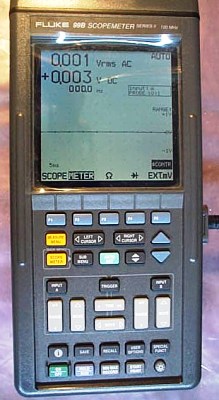
|
|
The Fluke 99B is a 2 Channel 100MHz ScopeMeter. It has ultra bright high contrast display, uses sophisticated technology to provide 25MSPS acquisition rate, and random repetitive sampling rates of 5 Gigasamples/sec. It also features one button access to automatic measurements; when selecting a measurement function, the test tool automatically chooses the best setup to analyze and compare complex waveforms, or simply to read voltage levels. Additionally, it has a large memory for front panel Setups, Waveforms, and Screens, a Min/Max TrendPlot function with time stamp for long term recording, and an optical to RS-232 interface port, with 600V isolation.
Specifications.
Vertical Mode.
Bandwidth: 100 MHz.
Coupling: AC, DC, Ground.
Sensitivity: 1 mV to 100 V/div.
Modes: A, -A, B, -B, A+B, A-B, X vs. Y.
Vertical resolution: 8 bits (256 levels).
Horizontal Mode.
Range: 5 ns/div to 60 s/div.
Acquisition modes: Recurrent, Single shot, Envelope, Roll, Glitch detect, Average, ScopeRecord.
Maximum sample rate: 5 GS/s for repetitive signals; 25 MS/s for single shot.
Maximum record length.
30k (up to 20ms/div-1 ch).
15k (up to 20ms/div-2 ch).
512 samples per channel (up to 5ns/div).
Trigger Mode.
Source: Input A, Input B, External.
Modes: Free run, Triggered, Single.
Types: Edge, Video, Event, N-cycle.
Video: Triggers on Field 1, Field 2, Lines or selectable line number.
Interlaced video: NTSC, PAL, PAL/M, SECAM, User selectable 2-Field or 4-Field sequence.
Non Interlaced video: Line selection up to 3200 lines.
Line frequency: 14 kHz to 65 kHz.
Time delay: Up to 20 divisions pre trigger view ; Up to 640 divisions trigger delay.
Cursor Measurements.
Up to 5 displayed simultaneously, Vrms (AC), Frequency, Vmean (DC), Risetime, Vpeak-peak, Time between cursors, Vmax-peak, Time at cursors (Time of day or Time from start), Vmin-peak, Phase dV between cursors, V at cursors. Measurements can be scaled to Amperes. Readouts in % change or delta-zero.
Memory Save and Recall.
40 Setup Memories.
20 Waveform Memories.
10 Screen Memories.
Meter Mode.
DC Voltage: 100 mV to 300V.
AC or AC+DC True RMS Voltage: 100 mV to 250V.
Accuracy.
50 Hz to 60 Hz (1%+10 counts).
20 Hz to 20 kHz(2%+15 counts).
5 Hz to 1 MHz (3%+20 counts).
DC to 5 MHz (10%+25 counts).
Signal Generator.
Sinewave: 1V pk-pk at 976 Hz with <-3% distortion.
Squarewave: 5V pk-pk at 488 Hz, 976 Hz, or 1.95 kHz.
Component Tester: Current or voltage ramp with 128 steps.
|